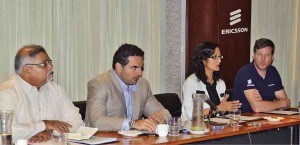Ericsson Response in Tacloban

FIRST RESPONDERS Team Ericsson, together with World Food Program, came to the country’s aid when the strongest typhoon hit its shores. They set up a communication mobile device to enable aid workers to become more efficient.
In any crisis situation, the ability to communicate may mean the difference between life and death. Sound decisions need to be made and communicated to those on the ground, enabling emergency responders to do their job effectively and efficiently.
This was evident last November when Super Typhoon “Yolanda” barreled through Eastern Visayas. It was classified a high-profile emergency by the United Nations. The storm claimed nearly 6,000 lives and total damage to infrastructure and agriculture reached P30 billion.
A day after the storm, the United Nations activated its resources and identified Tacloban, Guiuan and Roxas Cities as cluster areas, where support from the entire UN family was needed.
As part of its global relief effort in times of disaster, the UN forged strategic partnerships with key entities. Two of these were the first to respond to the Philippines’ call for help: World Food Program (WFP) and Ericsson Response.
Ericsson Response is committed to assist humanitarian relief organizations with communications technology and competence, enabling aid workers to do their jobs more efficiently.
Ericsson Response is composed of 140 volunteers. When the UN called on it for help, 15 volunteers immediately hopped on a plane and traveled to Tacloban to set up a system that enhanced mobile communications and multiple-access technologies.
Ericsson’s system incorporated the latest technology for radio-access networks and could work using all three communications standards: Global System for Mobile Communications (GSM) / Enhanced data rates for GSM evolution (EDGE), WCDMA/ High-speed packet access (HSPA) and Long term evolution (LTE).
With the portable device, which was small enough to fit in a backpack, Ericsson Response provided mobile communications that enabled people to make 6,000 calls.
The team also set up Wi-Fi spots for Internet connection and distributed mobile phones with which people could make free calls over Ericsson’s network.
Brainchild
Founded in 2000, Ericsson Response was the brainchild of company workers who simply wanted to contribute their skills and expertise in disaster relief situations.
It was a grassroots program that sprouted in a company where 110,000 people were employed worldwide.
Because of the crucial assistance offered by volunteers of the Ericsson Response program, global organizations such as the United Nations and WFP sought them out as partners.
“We believe we can make a difference with our technology. We are not in this for the publicity nor for the profit. We just want to provide assistance and lend our technical expertise to those who need it most,” says Rima Qureshi, senior vice president for strategic projects and head of Ericsson Response.
Qureshi says that, because of Ericsson Response, most employees choose to stay with the company.
“Millennials found it interesting to be working for something greater than themselves or money,” she says, referring to workers born in the early 1980s.
Employees who volunteer for disaster work are temporarily released from their responsibilities in Ericsson. The employees also undergo basic survival and psychological training before they are deployed in disaster areas.
“We did this before it became fashionable,” says Qureshi, referring to other companies that have implemented programs similar to Ericsson’s.
Praveen Agrawal, country director of WFP, describes the partnership to be a “win-win-win” situation.
He says people must “win” access to immediate relief.
“The government also wins because, through communication, it facilitates decision-making in a timely manner with critical information through movement of data,” Agrawal adds.
“Imagine, there are 6,000 people interconnected. The data is there to save lives. They are talking to each other through Ericsson Response. They worked with the teams on the ground to enhance the response through better communication.”
Logistically difficult
Of course, there are challenges in setting up the mobile communications system. Brent Carbno, along with 15 other Ericsson employees, found it “logistically difficult” to set up the

UNITED Nations World Food Programme director Praveen Agrawal (left), Elie Hanna, Ericsson Philippines and Pacific Islands president and country manager, Rima Qureshi, Ericsson senior vice president for Strategic Programs and head of Ericsson Response and Brent Carbno, Ericsson program director for Ericsson Response.
device.
“Though it was portable, lightweight and easy to move around, the hard part was finding a place to set it up. There was no power, no safe place to mount the device. We just did our best with what we had,” Carbno says.
There were only 15 Ericsson people who went to Tacloban after the disaster struck, but 150 more were working in the background, troubleshooting remotely.
Now on its second month, the Ericsson program now has over 6,000 registered users in three cities. The company will pull out once it sees a decline in usage of its system.
“Our role is to remove ourselves when the market is ready to stand on its own…. We will withdraw our services,” Qureshi says. “We will stay as long as requested … But we’re not here to compete with local operators.”
Offline
The device set up in Roxas City went offline last month. Agrawal says that this type of assistance is value-added and should not be considered a replacement.
“It should be complementing what’s already in place,” he explains.
Qureshi adds that the mobile communication device doesn’t require a lot of money nor does it need a lot of resources. Ericsson asks for donations for equipment and for people to lend their time and expertise.
“The cost is spread within the organization,” she says.
Together with the UN and WFP, Ericsson Response also works closely with the Emergency Telecommunications Cluster (ETC) in the Philippines to provide vital telecommunications and facilitate the delivery of humanitarian aid.














